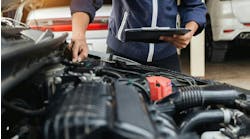Diesel Trucks Introduced
(Illustration: Delphi)
STUTTGART, GERMANY (May 9, 2006) - The Diesel Fuel Reformer System, a catalytic partial oxidation device under development at Delphi Corp., offers vehicle and diesel engine manufacturers a new strategy for achieving diesel exhaust aftertreatment regeneration and performance enhancement by enabling on-board hydrogen generation. So says Dephi's Dr. Joachim Krup, in an industry update presented at the Engine Expo held earlier this month in Stuttgart, Germany.
Through a catalytic partial oxidation process, the device converts diesel fuel into a hydrogen- and carbon monoxide-rich stream of gas, called "reformate." The reformate can be injected directly into the vehicle's exhaust system to achieve optimal regeneration and desulfation, says Krup, similar to a lean NOx trap aftertreatment system, which improves its emission reduction performance.
The hydrogen generated onboard also can be used to serve other purposes. For example, it can be used to generate ammonia and, thus, eliminate the need for an external reductant, such as urea, when using a selective catalytic reduction (SCR) system.
(Photo: Delphi)
Delphi says the Diesel Fuel Reformer System will facilitate unique exhaust aftertreatment strategies for light-, medium- and heavy-duty diesel vehicle systems, and the company intends to have the new technology to market by 2010. Delphi says the new product has a number of benefits, including:
* Enabling vehicle manufacturers to meet the stringent U.S. Tier 2 Bin 5 diesel emissions standard.
* Improving performance of the diesel aftertreatment system (Lean NOx Trap and Particulate Filter) and helps achieve regeneration at all engine operating conditions, including idle.
* Reducing the overall cost of a vehicle's exhaust aftertreatment system because it requires lower catalyst volume and reduced precious metal content.
* When coupled with a Lean NOx Trap, it provides an advantage that does not require an external reduction agent. This can eliminate the complexity, weight and higher cost associated with the supplementary dosing system.
* Also, when used as an alternative to urea SCR systems, it offers greater convenience for end-users, as concerns about refilling intervals are eliminated and there is no need for a urea infrastructure.
Delphi says the system provides automakers with a flexible, lower-cost solution to upcoming regulations, requires no major engine modifications or the addition of fluids, and performs well in both higher and lower temperature environments.
(Source: Delphi Corp.)


